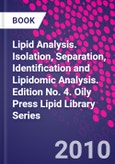This well-known and highly successful book was first published in 1973 and has been completely re-written in subsequent editions (published in 1982 and 2003). This new Fourth Edition has become necessary because of the pace of developments in mass spectrometry of intact lipids, which has given recognition of lipid analysis and 'lipidomics' as a distinct science. To bring the book up to date with these developments, author William W. Christie is joined by co-author Xianlin Han. Although devoting considerable space to mass spectrometry and lipidomics, Lipid analysis remains a practical guide, in one volume, to the complexities of the analysis of lipids. As in past editions, it is designed to act as a primary source, of value at the laboratory bench rather than residing on a library shelf.
Lipid analysis deals with the isolation, separation, identification and structural analysis of glycerolipids, including triacylglycerols, phospholipids, sphingolipids, and the various hydrolysis products of these. The chapters follow a logical sequence from the extraction of lipids to the isolation and characterization of particular lipid classes and of molecular species of each, and to the mass spectrometric analysis of lipids and lipidomics.
The new influence of mass spectrometry is due mainly to the development of electrospray ionization (ESI) and matrix-assisted laser desorption/ionization (MALDI). Most emphasis in this book is placed on ESI, which is enabling structural characterization of different lipid classes and the identification of novel lipids and their molecular species.
Lipid analysis deals with the isolation, separation, identification and structural analysis of glycerolipids, including triacylglycerols, phospholipids, sphingolipids, and the various hydrolysis products of these. The chapters follow a logical sequence from the extraction of lipids to the isolation and characterization of particular lipid classes and of molecular species of each, and to the mass spectrometric analysis of lipids and lipidomics.
The new influence of mass spectrometry is due mainly to the development of electrospray ionization (ESI) and matrix-assisted laser desorption/ionization (MALDI). Most emphasis in this book is placed on ESI, which is enabling structural characterization of different lipid classes and the identification of novel lipids and their molecular species.








